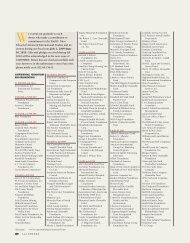Download Current Issue - SAIS
Download Current Issue - SAIS
Download Current Issue - SAIS
Create successful ePaper yourself
Turn your PDF publications into a flip-book with our unique Google optimized e-Paper software.
Resource Constraints on Food Supply<br />
There are only two ways to expand agricultural<br />
production: Increase the area<br />
planted (which, where climate permits,<br />
might include producing more than<br />
one crop on the same land each year),<br />
or increase the production per unit of<br />
land. Worldwide, farmers could double<br />
the number of hectares (one hectare<br />
is 2.47 acres) of land in production;<br />
however, there is only about 10 percent<br />
more potentially arable land that is not<br />
forested, highly erodible or subject to<br />
desertification. Expansion beyond this<br />
land would involve massive destruction<br />
of forests and, with them, wildlife<br />
habitat, biodiversity and carbon sequestration<br />
capacity, all while accelerating<br />
global warming.<br />
Most of the potentially arable land<br />
is inferior to that already in production<br />
and is located in remote areas of<br />
Sub-Saharan Africa and South America,<br />
which have minimal infrastructure. To<br />
sustainably double agricultural production<br />
will require most of the increase to<br />
come from greater production per unit<br />
of land already in cultivation.<br />
Availability of freshwater for agriculture<br />
may become an even larger<br />
constraint to doubling production than<br />
land availability. Farmers account for<br />
about 70 percent of the freshwater used<br />
in the world. With more than half of the<br />
world’s population living in cities now,<br />
a number projected to rise to 70 percent<br />
by 2050, the world’s farmers will no<br />
longer have access to 70 percent of the<br />
freshwater. Cities will outbid farmers<br />
for available water. Whereas farmers<br />
may have to double the average productivity<br />
of land already in agricultural<br />
production, they may have to triple the<br />
“crop per drop,” the output per unit of<br />
freshwater they use.<br />
Food Productivity and Security<br />
There are great differences among<br />
regions of the world in crop yields,<br />
which reflect differences in genetic<br />
potential embodied in the seeds<br />
planted, availability of water from precipitation<br />
or irrigation, adequacy of the<br />
nutrition available to the plants from<br />
the soil or fertilizer, and effectiveness<br />
of the control of weeds, insects, birds<br />
and diseases that reduce productivity<br />
Year of<br />
Agriculture<br />
at<strong>SAIS</strong><br />
relative to potential. The regional disparities<br />
in crop yields suggest it should<br />
be possible to significantly increase<br />
productivity per unit of land. With their<br />
low yields, many low-income countries’<br />
farm sectors contribute significantly<br />
less to their national food supply and<br />
global food security than they could.<br />
A century ago, cereal grain yields in<br />
Western Europe and the United States<br />
were not much higher than the low<br />
levels found in Sub-Saharan Africa<br />
today. The sizable gains in productivity<br />
since then have reduced the unit cost<br />
of production and have kept the price<br />
of food lower to the great benefit of<br />
poor consumers, who spend the largest<br />
fraction of their incomes on food. This<br />
has lessened the incidence of famine in<br />
the world and has allowed millions of<br />
hectares of trees to remain standing in<br />
the forests instead of being cut to make<br />
way for cultivation.<br />
Reducing Farm Household Poverty<br />
The majority of the world’s agricultural<br />
production takes place on family farms,<br />
where household members perform<br />
most of the labor. In addition to providing<br />
part of the family’s annual food<br />
supply, farming gives the household<br />
cash income—receipts from selling its<br />
products minus what it pays for production<br />
inputs (such as seed, fertilizer,<br />
pesticides and fuel) and hired labor.<br />
Most farm households earn significantly<br />
less than households whose<br />
income derives from other economic<br />
activities. In fact, 70 percent of the<br />
extreme poverty and associated hunger<br />
in the world is in rural areas, and most<br />
of the rural poor derive their meager<br />
incomes from farming.<br />
There are only five ways to lift lowincome<br />
farm households out of their<br />
poverty (other than from social welfare<br />
support, which rarely exists in rural<br />
areas of poor countries): Increase the<br />
productivity per hectare of land used<br />
in producing the crops being grown;<br />
change the mix of what is produced to<br />
crops with higher value per hectare; get<br />
access to more land (through purchase,<br />
rental or land reform) or other incomegenerating<br />
assets; opt for one or more<br />
members of the farm household to<br />
2011–2012 9



